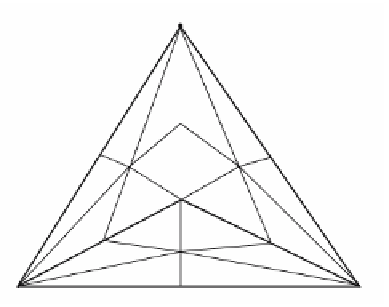Graphics Reference
In-Depth Information
Figure 7.32.
Defining the dual cells.
C
c
h
g
d
b
A
a
e
f
D
B
i
subdivision. The dual cell of the 1-simplex
AB
is the union of the two 1-simplices
ab
and
af
. The dual of the 2-simplex
ABC
is the 0-simplex
b
.
The dual cell s
n-k
will not necessarily be homeomorphic to
D
n-k
. It is if we are
dealing with a proper triangulation for a combinatorial manifold but not for an arbi-
trary pseudomanifold. For example, the dual cell of the vertices
p
in Figure 7.31 are
not disks. In order for the dual cells to have nice properties we do not need anything
as strong as a combinatorial manifold.
Definition.
A closed compact connected topological n-dimensional manifold is
called a
homology manifold
if it admits a triangulation (K,j) with the property that
the boundary of the star of every vertex in K is a homology (n - 1)-sphere.
Earlier results in this chapter show that the property of being a homology mani-
fold is a topological invariant.
7.5.5. Theorem.
(1) Every homology manifold is a pseudomanifold.
(2) An n-dimensional homology manifold is a manifold when n £ 3.
Proof.
See [SeiT80] or [Cair68].
Not every n-dimensional homology manifolds is a manifold when n > 4 (see
[SeiT80] for counterexamples), but they have enough in common to be able to prove
the important duality theorems in Section 7.5.2.
Returning to the dual of a k-simplex s
k
in a simplicial complex K that triangu-
lates a pseudomanifold
M
n
, we have
7.5.6. Proposition
.
(1) s
n-k
is an (n - k)-dimensional pseudomanifold.
(2) If
M
is a homology manifold, then ∂s
n-k
is an (n - k - 1)-dimensional homol-
ogy sphere.
(3) The simplex s
k
and its dual cell s
n-k
intersect in the single point b(s).



